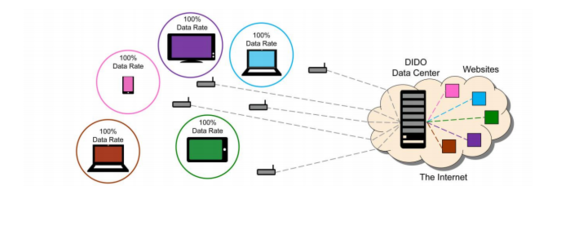
Normally, phones and tablets suffocate in large crowds, as their close proximity causes their data streams to become lost. A new startup, called Artemis, promises to eliminate that problem by actually using wireless interference to its advantage.
The founder, Steve Perlman, is relatively infamous in Silicon Valley circles: he launched WebTV and later OnLive, the cloud-gaming startup that turned inside-out when Perlman sold the company in a stock restructuring that wiped out all equity in the company, including his own. In 2011, however, Perlman began exploring the concept of Distributed Input, Distributed Output (DIDO), which he explained in a white paper published to his incubator, Rearden Labs.
Essentially, DIDO, like the Artemis technology it’s built upon, rethinks the concept of wireless interference. In a normal environment, each mobile phone or tablet “talks” to a cell tower, hopping channels and frequencies, and taking turns to avoid interference. The notion of “small cells”—essentially tiny towers mounted on light poles and other locations—also helps alleviate the problem by giving phones more communication points.

How Perlman’s DIDO technology works: signals pass through a data center, then out to existing devices.
But put too many phones into one location, and they start to stutter. Calls drop. Videos stop playing. Each wireless signal begins to interfere with one another, preventing all from working properly.
What Artemis proposes is to replace the small cells and other antennas with its own equipment, and create a “bubble” of constructive interference around each cell phone antenna. Based on a number of Internet videos Perlman and Artemis uploaded, the technology appears to be communicate where a phone is, and use that knowledge to give it a more comprehensive signal. Phones in a congested area “hear” a babble of voices, all shouting the same song or signal, but at offset frequencies and intervals. The Artemis technology appears to turn that babble into something like a chorus.
In a video, for example, Perlman showed off two 4K videos running alongside four 1080p videos, all running from a 10MHz of experimental spectrum. And they all played smoothly.
So far, Perlman hasn’t described how the Artemis technology works. But again, turning to the DIDO white paper, he makes it all pretty clear. Each Web site must be funnelled through a data center, which then broadcasts the signal to each device through a series of routers. The key, however, is that the signal must be sent to each device simultaneously, so that the interference is constructive, not destructive.
“The potential of DIDO is to have unlimited number of simultaneous users, all streaming high-definition video, utilizing the same spectrum that a single user would use with conventional wireless technology, with no degradation in performance, no dead zones, no interference between users, and no reduction in data rate as more users are added,” Perlman said.
In one of the demonstrations, Perlman shows how a device can be moved around the room, while the video streams flawlessly. But the white paper and the videos suggest a couple of key questions:
Does the technology require specialized server hardware or software? And if it does so, will carriers be willing to invest in it?How much will the specialized routers cost, and how many need to be installed to see tangible benefits? It appears, given the way the technology works, that a phone or tablet must be in radio range of at least two to see any benefit.How will signals be handed off from one router to another? And how tolerant will the Artemis technology be of moving vehicles or trains? If the signal absolutely must be sent simultaneously by the carrier to the phone, it would seem that this is a point of weakness.
To me, the last point is the most significant. Conventional LTE technology still isn’t perfect. But when consumers ride trains or buses, they want to be assured that they can still receive a signal—not just when they’re in a coffee shop. So far, we haven’t had a chance to speak with Perlman, or test the technology. While it might be a dumb idea to bet against a man who virtually invented the smart television and cloud gaming, Artemis still must answer some of these key questions before it can shake up the wireless industry.


